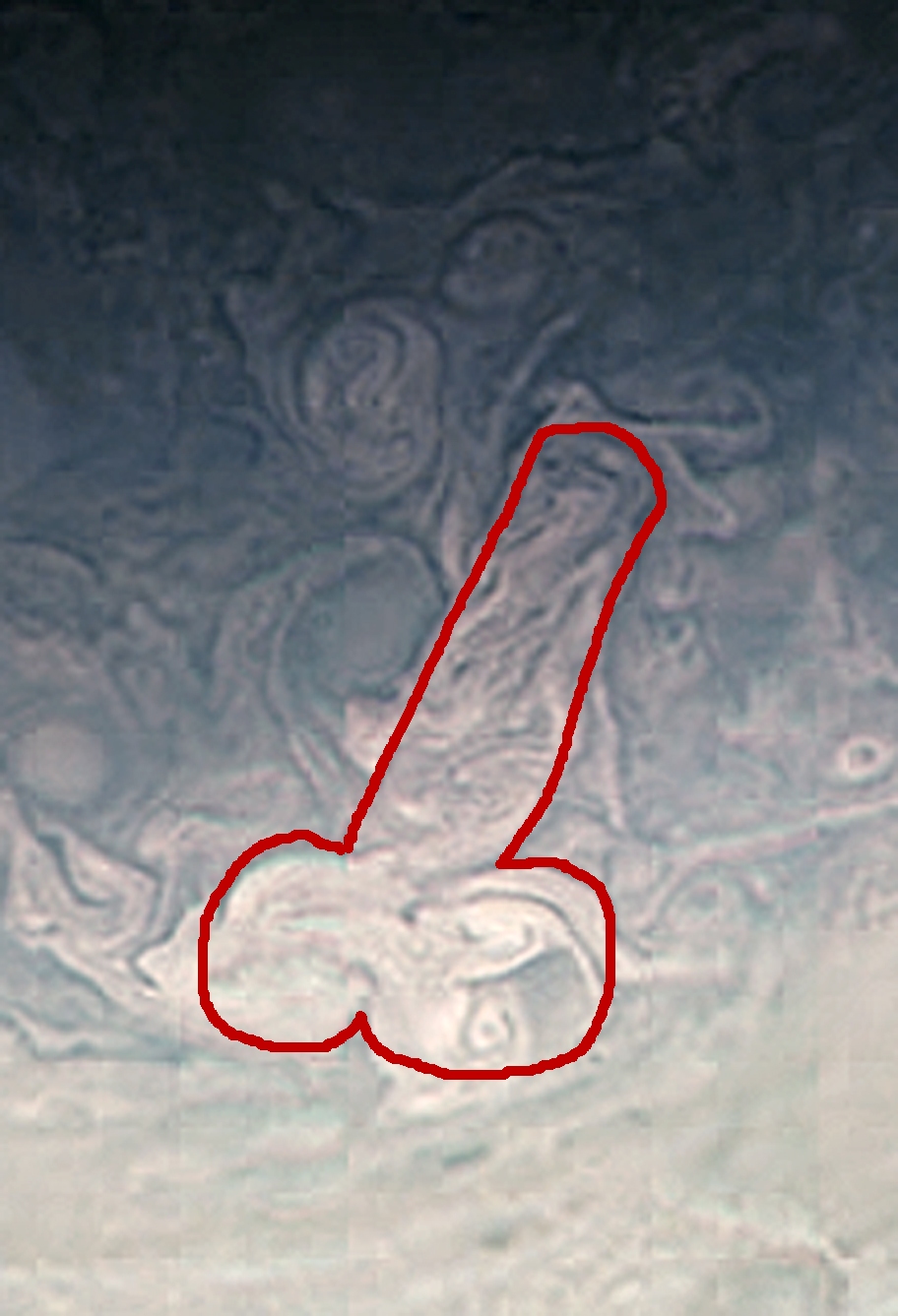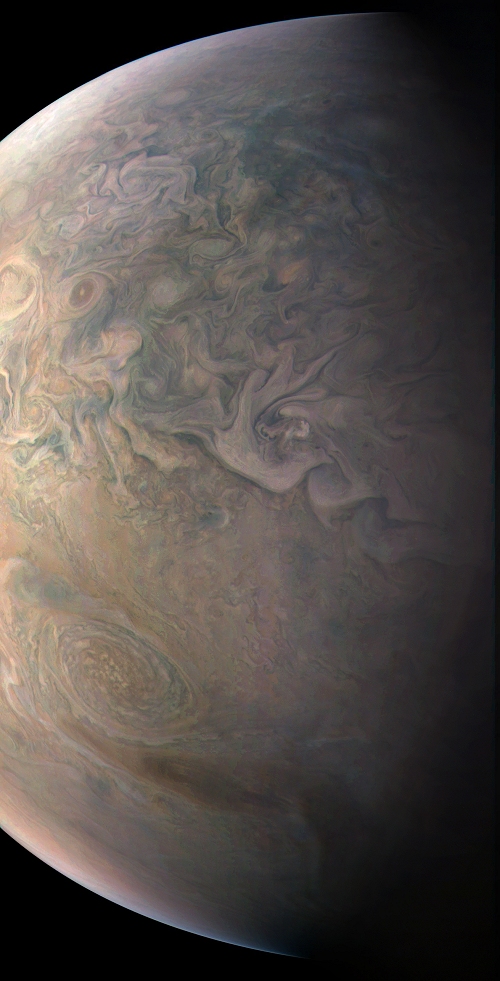It looks like you're using an Ad Blocker.
Please white-list or disable AboveTopSecret.com in your ad-blocking tool.
Thank you.
Some features of ATS will be disabled while you continue to use an ad-blocker.
share:
a reply to: glend
Juno is a scientific mission, and pictures are just a nice little bonus.
Still, Juno will give us the highest-resolution images than any spacecraft before it.
We just have to wait.
P.S. Turns out it's not the first time we've seen Jupiter's poles. Cassini (which has been my favourite space mission for years) has captured this "movie" of Jupiter's north pole: saturn.jpl.nasa.gov...
The video in the link reveals concentric rings and mini-storms riding around the pole.
Juno is a scientific mission, and pictures are just a nice little bonus.
Still, Juno will give us the highest-resolution images than any spacecraft before it.
We just have to wait.
P.S. Turns out it's not the first time we've seen Jupiter's poles. Cassini (which has been my favourite space mission for years) has captured this "movie" of Jupiter's north pole: saturn.jpl.nasa.gov...
Bands of eastward and westward winds on Jupiter appear as concentric rotating circles in a movie composed of Cassini images which have been reprojected to appear as if the viewer were floating over Jupiter's north pole. The sequence covers 70 days, from October 1 to December 9, 2000. Cassini's narrow-angle camera cap tured the images of Jupiter's atmosphere in near-infrared light.
The video in the link reveals concentric rings and mini-storms riding around the pole.
edit on 2-9-2016 by wildespace because: (no reason given)
a reply to: TheConstruKctionofLight You have a point with your post, yet your first link sites not shows existing Jupiter
temple, also the 2nd and 3rd links are total BS. However the NASA info you point out is totally on the topic. Thanx.
This, for me, is why I really don't need my Universe to be sprinkled with fairy dust or alien flashing lights to make it interesting - it's just
incredible as it is:

Oh, and look - a space dragon!

Oh, and look - a space dragon!
originally posted by: OneBigMonkeyToo
Oh, and look - a space dragon!
I guess if that's what you kids are calling it these days...

But yeah, fluid dynamics in space make for a captivating sight.

JPL have released audio made from the auroras of Jupiter’s north pole , eerie.
Among the more unique data sets collected by Juno during its first scientific sweep by Jupiter was that acquired by the mission’s Radio/Plasma Wave Experiment (Waves), which recorded ghostly-sounding transmissions emanating from above the planet. These radio emissions from Jupiter have been known about since the 1950s but had never been analyzed from such a close vantage point.
“Jupiter is talking to us in a way only gas-giant worlds can,” said Bill Kurth, co-investigator for the Waves instrument from the University of Iowa, Iowa City. “Waves detected the signature emissions of the energetic particles that generate the massive auroras which encircle Jupiter’s north pole. These emissions are the strongest in the solar system. Now we are going to try to figure out where the electrons come from that are generating them.”
www.nasa.gov...
Great thread. Absolutely love anything and everything regarding the "JUNO" mission. Actual new things being discovered everyday, and proving theories
wrong, or right. Thanks again for the thread. Awesome read.
Here's a rather fantastic recent Juno image:

Juno's Close Look at a Little Red Spot
Actually, the image I posted here is an improved version where I realigned colour channels and cleaned up the image artifacts. Here's the full-size version of it: imgur.com...

Juno's Close Look at a Little Red Spot
The JunoCam imager on NASA's Juno spacecraft snapped this shot of Jupiter's northern latitudes on Dec. 11, 2016 at 8:47 a.m. PST (11:47 a.m. EST), as the spacecraft performed a close flyby of the gas giant planet. The spacecraft was at an altitude of 10,300 miles (16,600 kilometers) above Jupiter's cloud tops.
This stunning view of the high north temperate latitudes fortuitously shows NN-LRS-1, a giant storm known as a Little Red Spot (lower left). This storm is the third largest anticyclonic reddish oval on the planet, which Earth-based observers have tracked for the last 23 years. An anticyclone is a weather phenomenon with large-scale circulation of winds around a central region of high atmospheric pressure. They rotate clockwise in the northern hemisphere, and counterclockwise in the southern hemisphere. This Little Red Spot shows very little color, just a pale brown smudge in the center. The color is very similar to the surroundings, making it difficult to see as it blends in with the clouds nearby. Citizen scientists Gerald Eichstaedt and John Rogers processed the image and drafted the caption.
Actually, the image I posted here is an improved version where I realigned colour channels and cleaned up the image artifacts. Here's the full-size version of it: imgur.com...
new topics
-
President-Elect TRUMP Picks Former Florida A.G. PAM BONDI to be U.S. Attorney General.
2024 Elections: 3 hours ago -
A Mysterious Orb filmed over NYC by local news
Aliens and UFOs: 5 hours ago -
Putin will warn civilians in targeted areas
World War Three: 6 hours ago -
The Popular Vote does not matter
Political Issues: 7 hours ago -
Gaetz withdraws from attorney general consideration
US Political Madness: 10 hours ago -
Bridgewater Triangle
General Chit Chat: 10 hours ago
top topics
-
Well we know Putins ICBMs won't fail in their silos
World War Three: 15 hours ago, 13 flags -
International Criminal Court Issues Arrest Warrant For Netanyahu
Mainstream News: 14 hours ago, 13 flags -
Gaetz withdraws from attorney general consideration
US Political Madness: 10 hours ago, 12 flags -
Is Russia Using a New Type of Beam Weapon Against Ukraine?
Weaponry: 12 hours ago, 11 flags -
Putin will warn civilians in targeted areas
World War Three: 6 hours ago, 10 flags -
President-Elect TRUMP Picks Former Florida A.G. PAM BONDI to be U.S. Attorney General.
2024 Elections: 3 hours ago, 10 flags -
racist rant, but she made the arguement to get rid of DEI
US Political Madness: 15 hours ago, 10 flags -
The Popular Vote does not matter
Political Issues: 7 hours ago, 8 flags -
Bridgewater Triangle
General Chit Chat: 10 hours ago, 7 flags -
Here is why Western leaders in NATO have zero fear of nuclear warfare. At all. Zero.
World War Three: 13 hours ago, 6 flags
active topics
-
Comcast dumping MSNBC
Mainstream News • 31 • : WeMustCare -
Encouraging News Media to be MAGA-PAF Should Be a Top Priority for Trump Admin 2025-2029.
Education and Media • 76 • : WeMustCare -
President-elect TRUMP Picks MATT GAETZ for his ATTORNEY GENERAL - High Level PANIC Ensues.
2024 Elections • 123 • : Vermilion -
Putin will warn civilians in targeted areas
World War Three • 26 • : KrustyKrab -
U.S. Closes Kyiv Embassy Over ‘Significant Air Attack’ Intelligence
World War Three • 46 • : KrustyKrab -
President-Elect TRUMP Picks Former Florida A.G. PAM BONDI to be U.S. Attorney General.
2024 Elections • 24 • : Xtrozero -
DNC Says it's CRAZY to Even Consider Replacing President JOE BIDEN as the Dem Nominee.
2024 Elections • 52 • : WeMustCare -
Gaetz withdraws from attorney general consideration
US Political Madness • 24 • : WeMustCare -
The Final Experiment is Scheduled for December 2024. Will it Finally Answer the Question?
Science & Technology • 25 • : Arbitrageur -
Post A Funny (T&C Friendly) Pic Part IV: The LOL awakens!
General Chit Chat • 7809 • : KrustyKrab
